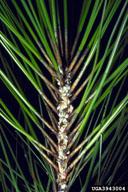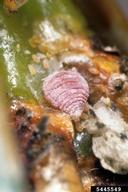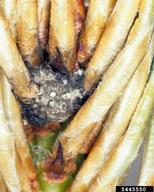The mealybug
Oracella acuta (Lobdell) (Hemiptera: Pseudococcidae)
Orientation to pest
The mealybug Oracella acuta (Lobdell) is native to the southeastern United States. It has up to five generations per year in the southern part of the range. First generation crawlers are the mobile dispersal stage. Once female crawlers finish dispersing, they either settle on the shoot or occasionally between the needles near the fascicle. Females secrete a characteristic white resin cell that covers their body. The tips of new shoots are the preferred settling site, though the entire shoot may be colonized when populations are high. The resin cells, shoots, and needles may become covered with black, sooty mold growing on honeydew produced by the mealybug. Males develop on the shoot within a covering called a test. First generation males are apterous, with subsequent generation males being alate. Infestations rarely cause tree mortality, but they may severely retard growth. Oracella acuta is a secondary pest, usually becoming a problem following insecticide applications targeting other insects.
Hosts commonly attacked
Hosts of this mealybug include loblolly (Pinus taeda L.), slash (Pinus elliottii Engelm.), Virginia (Pinus virginiana Miller), shortleaf (Pinus echinata Miller), and longleaf (Pinus palustris Miller) pine.
Distribution
In North America, this mealybug occurs from Florida north to Virginia and west to Texas. It is also invasive in China, where it has become a major pest in slash pine plantations.
Images of the mealybug
| Figure 1. A colony of the mealybug, Oracella acuta, on slash pine | Figure 2. Close up of the mealybug, showing an adult female and her eggs | Figure 3. A resin cell, formed by feeding of the mealybug |
Important biological control agents related to this pest species
Three native parasitoids, Zarhopalus debarri Sun, Acerophagus coccois E. Smith, and Allotropa oracellae Masner help regulate this mealybug's population size in the southeast United States. All three parasitoids were imported to China and released in heavily infested slash pine plantations, but failed to suppress the pest. One hypothesis about this failure is that it is due to the lack of mealybugs available as hosts in the summer months in China.
Articles
- Clarke, S. R., G. L. Debar, and C. W. Berisford. 1990. Life history of Oracella acuta (Homoptera: Pseudococcidae) in loblolly pine seed orchards in Georgia. Environmental Entomology 19: 99-103.
- Sun, J.-H., S. R. Clarke, G. L. Debarr, and C. W. Berisford. 2004. Parasitoid complex of the mealybug Oracella acuta (Lobdell) (Hemiptera: Pseudococcidae), in Georgia, USA. Journal Entomological Science 39(1): 11-22. (available on-line at http://www.srs.fs.usda.gov/pubs/ja/ja_sun005.pdf)
- Clarke, S. R., H.-B. Yu, M.-R. Chen, G. L. Debarr, and J.-H. Sun. 2010. Classical biological control program for the mealybug Oracella acuta in Guangdong Province, China. Insect Science 17: 129-139.(available on line at http://onlinelibrary.wiley.com/doi/10.1111/j.1744-7917.2009.01292.x/pdf)






